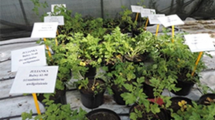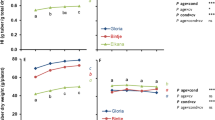Abstract
Three groups of single-halm potato plants were tested for water usage at different stages of growth under growth chamber, greenhouse and field conditions by conducting 24-hour uptake studies at weekly intervals. Although the water usage was higher and more variable in the greenhouse and field than in the growth chamber because of varying environmental conditions during the 24-hour test periods, similar patterns were obtained. From emergence, the potato plant appeared to have four growth stages based on morphological development and water use. The young plant stage from emergence to tuber initiation is characterized by rapid growth, high transpiration rate per unit of plant material (essentially foliage), transpiration significantly correlated with the amount of foliage and a higher percentage of moisture being retained in the plant. The second stage is essentially a short transition stage of tuber initiation where top growth continues, transpiration levels off and a lower percentage of moisture is retained in the plant. The third stage is the tuber bulking stage where transpiration and water use remain relatively static because of non-expanding top growth and a lower percentage of moisture being retained in the plant during the bulking process. The final stage of senescence and tuber ripening is characterized by a marked reduction in water use primarily because of lower transpiration and loss of functioning foliage.
Resumen
Se probaron tres grupos de plantas de papa de un sólo tallo para el uso de agua a diferentes estados de crecimiento bajo condiciones de cámaras de crecimiento, invernadero y de campo, conduciendo estudios de 24 horas de absorción en interválos semanales. Aunque el uso del agua fue más alto y más variable en el invernadero y el campo que en la cámara de crecimiento debido a las condiciones ambientales variables durante los períodos de 24 horas de prueba, se obtuvieron patrones de respuestas similares. Desde la emergencia, la planta de papa mostró tener cuatro estados de crecimiento basados en desarrollo morfológico y uso de agua. El estado de la planta jóven, desde la emergencia hasta la tuberización se caracteriza por su crecimiento rápido, alta rata de transpiración por unidad de material de planta (esencialmente follaje), transpiración significativamente correlacionada con la cantidad de follaje y el porcentaje más alto de humedad retenida en la planta. El segundo estado es esencialmente un estado corto de transición de initiación del tubérculo donde el crecimiento aéreo continúa, la transpiraciön se nivela y un porcentaje más bajo de humedad es retenido en la planta. El tercer estado es el estado de aumento de masa de los tubérculos donde la transpiraciön y el uso del agua permanecen relativamente estáticos debido a que no hay crecimiento expansivo aéreo y a que un porcentaje más bajo de humedad es retenido en la planta durante el proceso de aumento de masa. El estado final de senescencia y maduraciön del tubérculo es caracterizado por una marcada reducción en el uso del agua, principalmente debido a la baja transpiración y pérdida del follaje funcional.
Similar content being viewed by others
Literature Cited
Endrödi, Gabrilla and P. E. Rijtema. 1961. Calculation of evapotranspiration from potatoes. Neth. J. Agric. Sci. 17 (4): 283–299.
Hamilton, K.J. 1968. Moisture extraction patterns of irrigated crops. M.Sc. Thesis, Dept. of Soil Science, University of Saskatchewan, Saskatoon, Saskatchewan, Canada.
Nagy, Z., F. Bianu and V. Budiu. 1970. [Investigations of irrigation regimes and water consumption in potatoes.]. (Rumanian) Lucrâri Stüntifice Institutul Agronomic “Dr. Petru Guoza”, Cluj Agriculturâ (1970) 26, 201–208 (Field Crop Abstracts 26 (6): 2813).
Polevot, A.N. 1972. [Effect of the rate of plant development on the yield of potatoes.] (Russian) Trudy Institut Éksperimental’ noi Meteorologii. Glavonoe Upravienie Gidrometeorologicheskoi Sluzhby pri Sovete Ministrov S.S.S.R. No. 28, 113–116 (Field Crop Abstracts 26 (1): 353).
Salter, P.J. and J.E. Goode. 1967. Crop responses to water at different stages of growth. Research Review 2, Commonwealth Agricultural Bureau; Farnham Royal, Bucks, England.
Author information
Authors and Affiliations
Rights and permissions
About this article
Cite this article
Nelson, S.H., Hwang, K.E. Water usage by potato plants at different stages of growth. American Potato Journal 52, 331–339 (1975). https://doi.org/10.1007/BF02876050
Received:
Issue Date:
DOI: https://doi.org/10.1007/BF02876050




